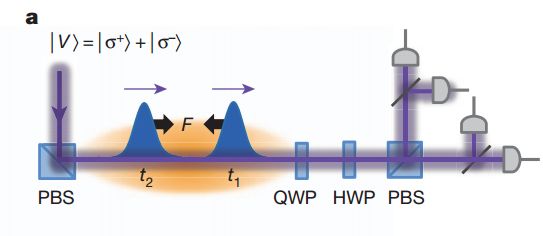|

September 25, 2013
from
PHYS
Website

Photons with
strong mutual attraction
in a quantum
nonlinear medium.
Credit: Nature.
Harvard and MIT scientists are challenging the conventional wisdom
about light, and they didn't need to go to a galaxy far, far away to
do it.
Working with colleagues at the Harvard-MIT Center for Ultracold
Atoms, a group led by Harvard Professor of Physics Mikhail Lukin
and MIT Professor of Physics Vladan Vuletic have managed to
coax photons into binding together to form molecules - a state of
matter that, until recently, had been purely theoretical.
The work is described in "Attractive Photons in A Quantum
Nonlinear Medium", a September 25
paper in Nature.
The discovery, Lukin said, runs contrary to decades of accepted
wisdom about the nature of light.
Photons have long been described as
massless particles which don't interact with each other - shine two
laser beams at each other, he said, and they simply pass through one
another.
"Photonic molecules," however,
behave less like traditional lasers and more like something you
might find in science fiction - the light saber.
"Most of the properties of light we know about originate from
the fact that photons are massless, and that they do not
interact with each other," Lukin said.
"What we have done is create a
special type of medium in which photons interact with each other
so strongly that they begin to act as though they have mass, and
they bind together to form molecules. This type of photonic
bound state has been discussed theoretically for quite a while,
but until now it hadn't been observed.
"It's not an in-apt analogy to compare this
to lightsabers," Lukin added.
"When these photons interact with
each other, they're pushing against and deflect each other. The
physics of what's happening in these molecules is similar to
what we see in the movies."
To get the normally-massless photons to
bind to each other, Lukin and colleagues, including Harvard
post-doctoral fellow Ofer Fisterberg, former Harvard doctoral
student Alexey Gorshkov and MIT graduate students Thibault
Peyronel and Qiu Liang couldn't rely on something like the Force -
they instead turned to a set of more extreme conditions.
Researchers began by pumped rubidium atoms into a vacuum chamber,
then used lasers to cool the cloud of atoms to just a few degrees
above absolute zero. Using extremely weak laser pulses, they then
fired single photons into the cloud of atoms.
As the photons enter the cloud of cold atoms, Lukin said, its energy
excites atoms along its path, causing the photon to slow
dramatically.
As the photon moves through the cloud,
that energy is handed off from atom to atom, and eventually exits
the cloud with the photon.
"When the photon exits the medium,
its identity is preserved," Lukin said.
"It's the same effect we see with
refraction of light in a water glass. The light enters the
water, it hands off part of its energy to the medium, and inside
it exists as light and matter coupled together, but when it
exits, it's still light. The process that takes place is the
same it's just a bit more extreme - the light is slowed
considerably, and a lot more energy is given away than during
refraction."
When Lukin and colleagues fired two
photons into the cloud, they were surprised to see them exit
together, as a single molecule.
The reason they form the never-before-seen molecules?
An effect called a
Rydberg blockade, Lukin said, which states
that when an atom is excited, nearby atoms cannot be excited to the
same degree. In practice, the effect means that as two photons enter
the atomic cloud, the first excites an atom, but must move forward
before the second photon can excite nearby atoms.
The result, he said, is that the two photons push and pull each
other through the cloud as their energy is handed off from one atom
to the next.
"It's a photonic interaction that's
mediated by the atomic interaction," Lukin said.
"That makes these two photons behave
like a molecule, and when they exit the medium they're much more
likely to do so together than as single photons."
While the effect is unusual, it does
have some practical applications as well.
"We do this for fun, and because
we're pushing the frontiers of science," Lukin said.
"But it feeds into the bigger
picture of what we're doing because photons remain the best
possible means to carry quantum information. The handicap,
though, has been that photons don't interact with each other."
To build a quantum computer, he
explained, researchers need to build a system that can preserve
quantum information, and process it using quantum logic operations.
The challenge, however, is that quantum
logic requires interactions between individual quanta so that
quantum systems can be switched to perform information processing.
"What we demonstrate with this
process allows us to do that," Lukin said.
"Before we make a useful, practical
quantum switch or photonic logic gate we have to improve the
performance, so it's still at the proof-of-concept level, but
this is an important step. The physical principles we've
established here are important."
The system could even be useful in
classical computing, Lukin said, considering the power-dissipation
challenges chip-makers now face.
A number of companies - including IBM -
have worked to develop systems that rely on optical routers that
convert light signals into electrical signals, but those systems
face their own hurdles.
Lukin also suggested that the system might one day even be used to
create complex three-dimensional structures - such as crystals -
wholly out of light.
"What it will be useful for we don't
know yet, but it's a new state of matter, so we are hopeful that
new applications may emerge as we continue to investigate these
photonic molecules' properties," he said.
Scientists 'Bind Photons Together'
...to
Create New State of Matter Comparable to Lightsabers
by James Vincent
26 September 2013
from
TheIndependent Website

Under extreme
temperatures
photons were made to
behave like molecules,
a feat previously
thought impossible
A group of scientists from Harvard and MIT have created a state of
matter that until now has only been found in the realms of science
fiction.
The physicists were exploring the properties of photons - an
elementary particle that is the most basic constituent of light and
all other types of electromagnetic radiation - when they managed to
create molecules formed from photons bound together.
The discovery is startling as it goes against what scientists have
previously believed to be the signature quality of photons: that
they are massless particles that do not interact with each other.
The capacity to create molecules out
of photons has been described by the physicists involved as,
“pushing the frontiers of science”.
"Most of the properties of light we know about originate from
the fact that photons are massless, and that they do not
interact with each other," said Harvard Professor of Physics
Mikhail Lukin in a press release published at phys.org.
"What we have done is create a special type of medium in which
photons interact with each other so strongly that they begin to
act as though they have mass, and they bind together to form
molecules.”
“It's not an in-apt analogy to compare this to lightsabers,"
Lukin added.
"When these photons interact with
each other, they're pushing against and deflect each other. The
physics of what's happening in these molecules is similar to
what we see in the movies."
To get the photons to interact with one
another the team from the Harvard-MIT Center for Ultracold Atoms (a
group led by Mikhail Lukin alongside MIT Professor of Physics
Vladan Vuletic - see '
Attractive Photons in A Quantum
Nonlinear Medium') cooled rubidium atoms in a
vacuum chamber to just a few degrees above absolute zero - the
coldest possible temperature at which particles do not move.
When two photons were fired at the cloud they did not pass through
it and exit individually (as had been expected) but emerged on the
other side as a single molecule.
This was due to
the Rydberg blockade, which states
that when an atom is excited (has energy imparted to it) nearby
atoms cannot be excited to the same degree.
This meant that as the first photon excited atoms in the cloud but
had to move on before the second photon could do the same.
Lukin describes the end result as the
photons pushing and pulling each other through the cloud.
"It's a photonic interaction that's
mediated by the atomic interaction," said Lukin.
"That makes these two photons behave
like a molecule, and when they exit the medium they're much more
likely to do so together than as single photons."
The scientists involved are hoping to
use their discovery to aid quantum computing (rather than build
futuristic weaponry) as that technology would rely on photons to
carry and exchange quantum information.
"What it will be useful for we don't
know yet,” said Lukin, “but it's a new state of matter, so we
are hopeful that new applications may emerge as we continue to
investigate these photonic molecules' properties.”
|



